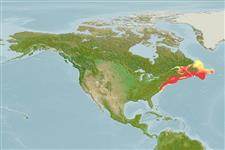Common names from other countries
Classification / Names / Names
ماع يماسا | فدارتم | Catalog of Fishes (gen., sp.) | ITIS | CoL | WoRMS
Environment: milieu / climate zone / depth range / distribution range
يسانش موب
; قمع تارييغت 0 - 480 m (Ref. 4), usually 4 - 50 m (Ref. 4). Temperate, preferred 6°C (Ref. 107945); 54°N - 35°N, 78°W - 52°W (Ref. 4)
Northwest Atlantic and Western Atlantic.
Length at first maturity / Size / Weight / نس
Maturity: Lm 8.8, range 7 - 9 cm Max length : 114 cm TL يسنج صاوخ نودب / رن سنج; (Ref. 81053); common length : 25.0 cm TL يسنج صاوخ نودب / رن سنج; (Ref. 4); هدش شرازگ نزو هنيشيب: 1.7 kg (Ref. 81053)
Benthic in coastal and shelf waters (Ref. 106894). Possibly a selective feeder, preying mainly on crabs, echinoderms, mussels and polychaetes but also ingesting algae and seaweeds, with a complex foraging behavior and thus capable of maintaining gross diet composition despite of sharp variations in prey availability, seasonality and ontogenetic changes, e.g., molt- and size-related diet shifts (Ref. 33024). Migration does not occur, or only to a limited scale (Ref. 4).
Life cycle and mating behavior
غولب | لثم دیلوت | یزیر مخت | اه مخت | Fecundity | )ورال ( دازوت
The females carry their eggs for 10 to 11 months, ovigerous females are found throughout the year (Ref. 4). 0.5 broods per year (Ref. 81148); 0.15 cm postlarval size (Ref. 81158); 1 month pelagic period (Ref. 81159).
یلصا ذخآم
عجارم | هدننك گنهامه | ناراكمه
Holthuis, L.B. 1991. (Ref. 4)
NCUI زمرق تسرهف رد تيعضو (Ref. 130435)
ستياس رظن زا تيعضو (Ref. 108899)
Not Evaluated
Not Evaluated
یناسنا هدافتسا
تاليش – يريگ يهام: الاب يراجت شزرا اب
FAO - تاليش – يريگ يهام: landings, هنوگ هيامن | FishSource | Sea Around Us
اهرازبا
يتنرتنيا عبانم
Estimates based on models
Preferred temperature
(Ref.
115969): 2.7 - 15.4, mean 10.2 (based on 112 cells).
یگدنهج
مك ، نيياپ, لاس 41 – 4/5 تيعمج ندش ربارب ود يارب مزال نامز هنيمك (K=0.07-0.09; tm=5).
Prior r = 0.47, 95% CL = 0.31 - 0.71, Based on 2 full stock assessments.
یريذپ بيسآ
Moderate to high vulnerability (46 of 100).
